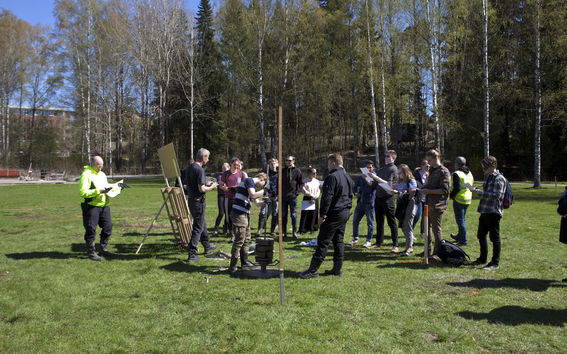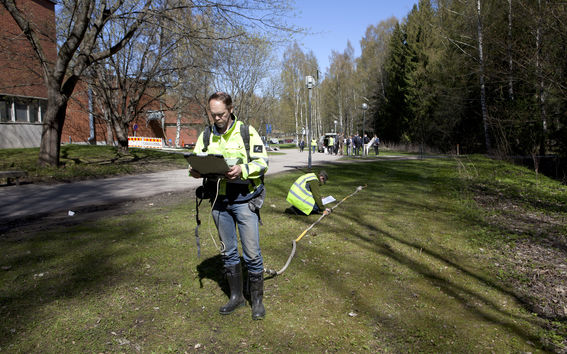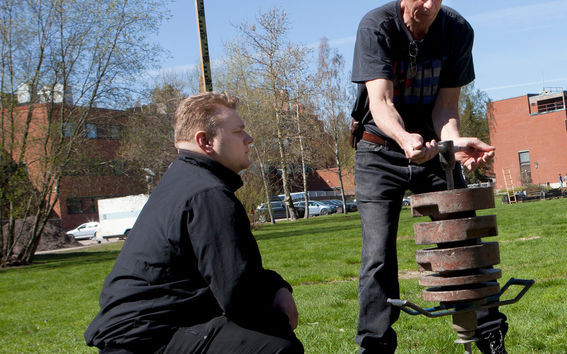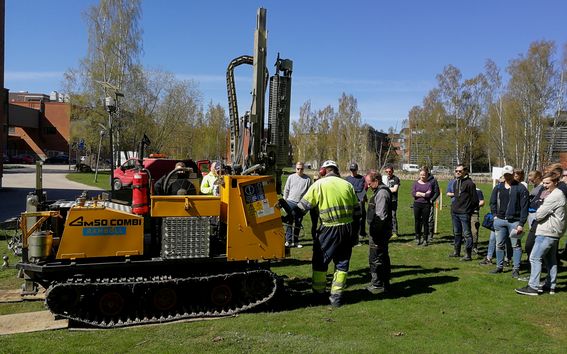Getting familiar with ground properties in field exercises of Geoengineering

During the day, approximately 200 students in small groups familiarised themselves with the equipment and completed related exercises in the Ossinlampi environment and in the forest nearby. The students represented two courses: Geology and geomechanics and Geoengineering and georesources.
‘According to the soil map, we are now in the blue zone, which means that the soil is claye and quite poorly suited for construction’, says University Teacher Henry Gustavsson. ‘Below us, we have soft clay with a thickness of 3,5 to 15 metres. The clay is so soft that the buildings have to be constructed on piles.’
The quality of the soil is tested with a weight sounding test. Taneli Helminen, a student majoring in Energy and Environmental Technology, does not hesitate to grab the device for weight sounding.
‘The weight sounding rod’s sharpened, carrot-like tip penetrates vertically into the ground. Weights are added, and the aim is to make the rod sink at the speed of 2–5 cm / second. If the speed is too fast, we reduce weight. If it's too slow, we add weight. Everything is recorded’, Gustavsson teaches.
Weight sounding is not always that light. Two students are needed to get the work started. Soon soft clay seeps out of the borehole. It feels strange under the feet, but according to the teacher, there is no reason for concern,
‘There is a proper dry crust here, which can even support a vehicle. Closer to the seaside, the constuctability category is 6, meaning that construction is extremely difficult. However, expensive land and the seaside make people build in such areas, too’, says Gustavsson.
Helminen, who is interested in water and environmental technology, says that also geotechnics have started to interest him during the field course.
‘I have not yet decided the programme for my master's degree, but I am becoming interested in sectors connected with the environment. They are the sectors of the future’, he thinks.
Next, the group moves to an area very suitable for construction and belonging to constructability category 2. In such areas, it is possible to use ground supported foundations, as the soft soil layer on top of the dense, coarse grained soil layers is no more than three metres in thickness.

Assistance for using the ground penetrating radar was provided by DSc (Tech) Tero Hokkanen, with a doctoral degree in geophysics from Aalto University.
The undergraduate course YYT-C2003 open to all was carried out in spring with the assistance of Ramboll soil investigation machines. It took place in the backyard of the building of Civil and Structural Engineering, in the Ossinlampi environment and in the forest nearby.

Henry Gustavsson shows Taneli Helminen (left) how to use a device for weight sounding.

- Published:
- Updated:
Read more news

DeployAI Partners Gather for Heart Beat Meeting in Helsinki
The European DeployAI project's partners gathered for the Heart Beat meeting hosted by Aalto University Executive Education in Helsinki.
Online AI course could boost study equality
Students at the School of Business believe that mastering Artificial Intelligence (AI) can be beneficial for both academic success and career prospects, as AI becomes increasingly integrated into daily life.
2 027 new students admitted to Aalto University’s Finnish, Swedish bachelor’s programmes
13 500 applied to Aalto University in Finland's spring joint application in 2024